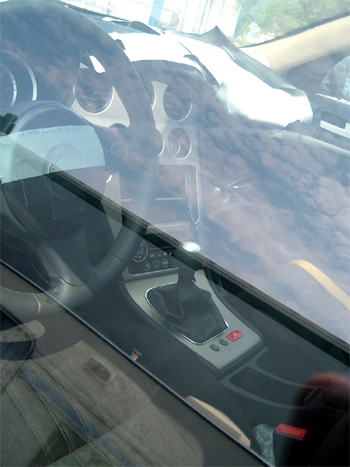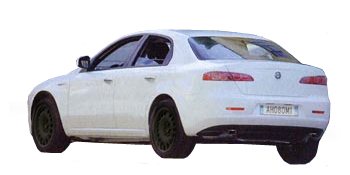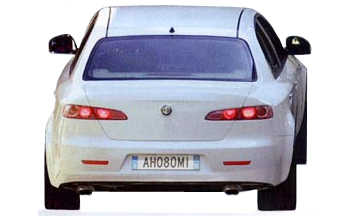14.08.2004 the closest look yet at the new Alfa romeo 156 replacement
The launch of the Alfa Romeo 156 in 1997 stunned car enthusiasts worldwide. It was immediately proclaimed as a modern-day classic; its beautiful styling, remarkable handling and good build quality made it a serious contender against the likes of the Audi A4 and BMW 3-Series. Alfa Romeo's chief designer at the time, Walter Maria de Silva, literally became famous overnight.
Now, seven years later, Alfa Romeo engineers are fine-tuning the next-generation. Set for launch at the upcoming Geneva Motor Show in March 2005, codename Project 939 is aiming to become another benchmark in the automotive industry.
The task of replacing the much-loved Alfa 156 was given to Giorgetto Giugiaro, a master-designer with good insight towards the Alfa Romeo brand. Giugiaro recalls,
“Alfa Romeo is a Marque that made a strong impression on my designer career. The first series-produced car I designed was the Alfa 2000 Sprint. Italdesign itself was created to give life to the Alfasud project.
Over now what must be almost a career span of fifty years, I found myself designing cars on more than one occasion for the “Biscione” carmaker, sometimes by way of contract, and sometimes in sheer freedom”.
The Brera concept represented this "sheer freedom" and subsequently won the prestigious Concept Car of the Year award in 2002. The basic lines of this highly-praised study have been successfully translated to the new production 'berlina'. The nose especially has a lot in common with the Brera, with three separate headlight projectors and similar grille treatment. The no-nonsense headlight design will provide excellent lighting qualities, especially if applied with xenon technology.
Evolving the rear end styling of the 156, the rear of the newcomer has a built-in spoiler on the leading edge of the boot, improving aerodynamics and emphasizing the performance of the machine. In the style of the Brera, the taillights are positioned in round chromed accents positioned behind semi-clear red lenses. The flanks are a logical progression from the 147, with sharper and more defined creases offset by organically-shaped wheel arches of generous size.
Gone are the 'hidden' rear door handles; perhaps a stylistic indication towards the improved interior space on the newcomer. The wheelbase itself has been increased from 2,595 mm to 2,805 mm, 105 mm longer than that of the flagship Alfa 166 model. The increase of length in the interior directly benefits the rear passengers, providing a new level of luxury for Alfa Romeo in this market segment. The rear overhang has also been increased by 10 mm to 1,530 mm.
The new Alfa Romeo's generous dimensions have been realised through using the Premium platform. This platform was jointly developed by Fiat and Saab in Pixbo, Sweden. Saab intended to use it for their 9-5 replacement until it was deemed too expensive by General Motors, ultimately cancelling the Swedish carmaker's involvement. Alfa Romeo are therefore the first to use the platform, with Fiat following closely with their New Large. Naturally, Alfa Romeo engineers have developed the platform to their own liking, thrashing it around the Nuerburgring and their proving grounds in the artic circle. The latter enables the engineers to properly develop the suspension setup, as the cars approach their handling limits far quicker on icy surfaces. Undoubtedly, the Premium base will have been transformed into a platform worthy of the famed Italian sportscar brand.
Initially the familiar 1.9 and 2.4 JTD engines will be offered, and both have been redeveloped for Euro 4. The four-cylinder 1.9 will be offered with 120 and 150 bhp, whilst the five-cylinder 2.4 will be available with 200 bhp. An all-new 3.0 JTD sourced from either Isuzu or VM will mark the highest capacity diesel, producing 250 bhp with integral (4x4) transmission and an automatic Aisin gearbox. This engine is also Euro 4 certified.
The petrol range will initially start with the 2.0 JTS, with an Opel-sourced 1.8 JTS developing 160 bhp coming on-stream in 2006. Available directly, and also emanating from Opel's GDI range (L850), will be the 1.9 JTS (160 bhp) and 2.2 JTS (185 bhp) units. Both of these models will be fitted with 6-speed transmissions. Two 3.2 V6 engines will also be offered. The first, fitted to the GTA model with a Biturbo VCPh, is a 400 bhp version of the engine fitted on the current range and will only be offered with integral transmission from 2006. A second 3.2 V6, a JTS unit of 60° will be sourced from Holden-GM in Australia and will produce 260 bhp.
 |
|
|
|
  |
|
|